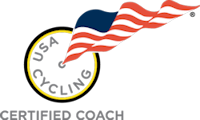While your training plan and racing tactics are extremely important, you can’t forget the little things that can make or break a race. One of those little details is pinning your number on properly. While a rare situation, it’s no joke – screwing up your number plate could get you disqualified!
What worse way to lose a race than by getting disqualified for a simple rule violation?
So here is what to do when you get your race number from the registration tent…
First, get the number out of your bag, and make sure you have at least four safety pins. If possible, grab eight safety pins. (If you do enough races, you probably have at least eight pins lying in your car!)
Why eight pins, when there are just four holes in the number plate?
I’ll tell you why. It’s a technique called “flat pinning” and it’s a generally agreed upon way to pin your number down so it’s flat, secure, and aerodynamic.
With flat pinning, you skip the pre-punched holes on the number and go straight through the paper/fabric of the number plate. This helps keep the number completely flat against your jersey so it doesn’t flap in the wind! (Even if a loose number plate isn’t a huge aerodynamics problem, the sound of it flapping around is rather annoying!)
If you choose to use four pins, you will pin through the four corners of the number. If you choose to use eight pins, you’ll pin through the four corners plus each of the four sides. It depends on how strict you are about a super aerodynamic number plate!
The actual technique requires you to stick the pin down through the number, through your jersey, back into and up through your jersey, and through the number again before closing the pin.
Once you practice it one time you’ll get it.
The next topic for number plates is crinkling and rolling your number plate.
Typically, the number plate is going to be made of stiff, heavy paper. Even with flat pinning, it can be hard to get it perfectly flat against the curve of your body.
So what riders will do is crinkle the number up into a ball (then unroll it) before pinning it to their jersey. This loosens up the paper and helps it conform to your body.
If crinkling it into a ball seems too much, you can also roll it up (like putting a poster into a cardboard tube) in a couple directions so it’s no so flat. This will do less damage to the number.
Note: Crinkling is a good technique for the fabric numbers, while rolling works better for paper/cardboard numbers.
The controversy over crinkling your number actually comes from the USCF rules. Technically, any modification to your number plate (which includes crinkling) violates USCF rules.
The rule comes from the possibility of race officials not being able to get a good view of your number, like if the crinkles reflect the sun some way where the finish line camera doesn’t pick up your number.
I’ve never actually seen this enforced, but it’s risky. Especially if you do something to get on the official’s bad side. (Who knows, maybe one of the officials was the kid you bullied in middle school? He might get revenge by disqualifying you for a manipulated number plate!)
Now, if it’s just a local race, no one will care. You’ll probably have a timing chip anyway, and no finish line camera.
The only thing to worry about is not pinning down the little tear-off tab on the bottom! (Same as the number plates used in a 5k.)
As for number placement in a road bike race, it will most likely lie parallel to your back, on the left side (people to your left can read the number, people behind you will have to tilt their heads sideways.)
In a mountain bike race, it’s more likely you’ll have a number plate on your handlebar. However, you could also have a number on your left or right hip.
For more info on race number placement (it varies with each race, so the more info you have, the better,) check out this link:
- Race numbers: Pinning and Placement – Help with number placement and pinning for road bike racers.
Levi Bloom is an experienced endurance athlete who has been training and competing for over 17 years. A former Cat 1 road and mountain bike racer (professional class on the regional circuit), he is now a cycling coach (USA Cycling Level 3 Certified) and sports nutrition coach (Precision Nutrition Level 1 Certified).









Leave a Reply